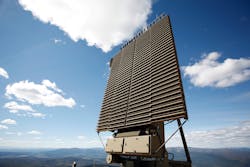Lockheed Martin will collaborate on radar with Weibel Scientific that fill gaps in ballistic missile defense systems, while being immune to interference from buildings and other large obstacles.
The companies plan to design the gap-filling tracking radar so that it can continuously transmit and receive ultrasound waves. That will enable the radar system to measure the velocity and position of ballistic missiles in real-time.
The GFTR system is still in development and few details have been released. But it will probably share technology used in Weibel's continuous wave Doppler radar, which contain multiple receivers and advanced signal processing to calculate location. Typically, CW Doppler radar usually only provides an object's velocity.
Weibel's multi-frequency surveillance and tracking radars include phased-array antennas, beam-shaping transmitters, and multi-beam receivers to target moving objects at distances further than 1,000 km. The GFTR system will be designed, developed, and tested at Weibel's facilities in Denmark, with Lockheed providing support from its development site in New Jersey.
Over the years, Weibel has had several contracts with the U.S. Department of Defense. In 2012, the company was received a $36-million order of 1,995 Doppler radars for missile defense applications. Weibel's multi-frequency tracking radars have also been used by NASA to track debris during rocket launches.
About the Author

James Morra
Senior Editor
James Morra is the senior editor for Electronic Design, covering the semiconductor industry and new technology trends, with a focus on power electronics and power management. He also reports on the business behind electrical engineering, including the electronics supply chain. He joined Electronic Design in 2015 and is based in Chicago, Illinois.
